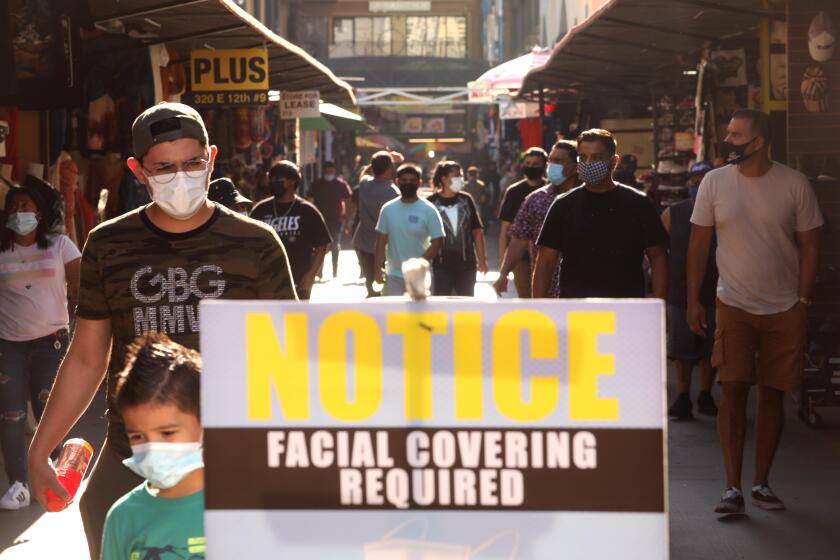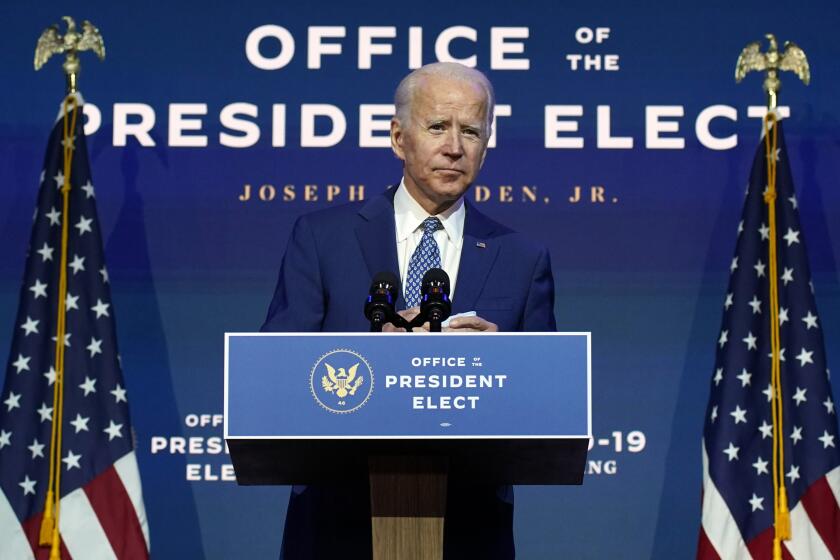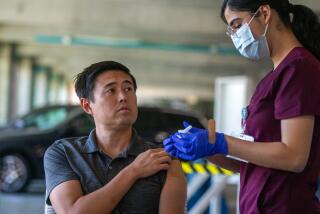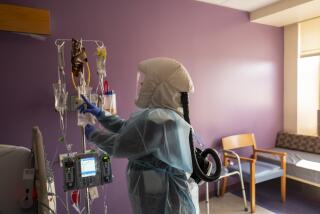L.A. County declares new coronavirus surge, sparking increased alarms

- Share via
After weeks of rising coronavirus numbers, officials Monday said Los Angeles County was seeing a new surge in infections that could get worse as Thanksgiving approaches.
Health authorities have been saying for weeks that social gatherings — including celebrations tied to the Lakers and Dodgers championship victories — were helping spread COVID-19 and dashing hopes of further reopening the economy before the holidays. But on Monday, officials said that conditions were deteriorating further.
The new surge is so far less extreme than the disastrous summer spike that led to rises in both hospitalizations and deaths. But officials fear fatigue after months of restrictions is causing people to let down their guard at a critical moment.
“These numbers are demonstrating real and alarming increases, and the next two weeks will be crucial,” county Public Health Director Barbara Ferrer said. “As we go into our cooler months and our holidays, we are increasingly worried about more and more transmission of the virus and more hospitalizations and deaths from COVID-19.”
In L.A. County, officials announced at least 2,000 new coronavirus infections every day from Thursday through Sunday.
On Monday, the county reported more than 1,431 new cases, but Ferrer said numbers typically come in lower at the start of the week because of reporting lags over the weekend.
Prior to the recent rash, the last time the county’s daily case count had surpassed 2,000 without being inflated by a reporting backlog was Aug. 15, according to The Times’ tracker.
During the seven-day period that ended Sunday, Los Angeles County reported more than 13,000 cases, a 38% jump from the previous week and the highest number of weekly cases in more than two months.
The rise in cases has been steady and sustained. In early October, L.A. County’s seven-day average of coronavirus cases stood at about 940 new cases a day. For the seven-day period that ended Sunday, there were an average of 1,860 cases daily.
“This isn’t a blip any longer. This isn’t, ‘Oh, you know, we had one bad weekend. And, you know, we’re now getting back under control,’ ” Ferrer said. “This is now a surge in our cases. And if it continues, it will be quite alarming to go into our coldest months seeing this level of increase in cases.”
While California has started to see a rise in coronavirus cases, the pace of increase is slower than that seen in the rest of the United States.
Ferrer said the alarming numbers should be a call for Angelenos to rededicate themselves to the oft-recited protocols for how to stifle transmission: Wear masks in public, maintain physical distance from those you don’t live with, stay home when you’re sick, regularly wash your hands and avoid gatherings.
Any backsliding from those practices, she warned, not only could put residents’ health at risk, but also jeopardize the county’s ability to further reopen businesses and other public spaces.
“We don’t have the luxury of ignoring our individual and collective responsibilities if we want to see more children go to school and businesses remain open,” she said. “Recovery just doesn’t continue when you have thousands of new cases each day. And many of these cases stem from people taking risks that are, frankly, not appropriate. It isn’t that hard to play by the rules, especially since these rules are what keep some people alive and allow our economy to improve.”
Gatherings have emerged as a particular point of concern for health officials.
Experts and health officials throughout the state have for weeks urged residents to avoid gatherings as much as possible, or at least to take precautions such as wearing face coverings, staying outdoors and keeping at least six feet away from members of other households.
Such steps are all the more vital now, officials say, as California looks to avoid the sizable spikes currently striking many other areas of the country. The United States officially surpassed 10 million total confirmed COVID-19 cases Monday, according to data from Johns Hopkins University.
The swift unveiling of the coronavirus advisory board signals the urgency of the issue and its importance in propelling Biden to the White House.
L.A. County isn’t alone in seeing a troubling surge in coronavirus infections. Santa Clara County reported 358 new cases Sunday — its second-highest daily total, behind 385 recorded July 15.
“These trends serve as a stark reminder that COVID-19 is all around us,” Dr. Sara Cody, the county’s health officer and director of public health, said in a statement. “Each and every one of us needs to redouble our efforts to keep our community safe.”
Statewide, the seven-day average for new cases is 5,889, up from the 14-day average of 5,060.
Should the current case trend hold, it’s conceivable that California could reach 1 million recorded coronavirus cases later this week.
The state also seems certain to surpass another grim milestone in the not-too-distant future: 18,000 deaths.
As to why the numbers are going up in California, Gov. Gavin Newsom said Monday: “It’s for obvious reasons: People are letting their guard down.
“They’re taking their masks off; they’re starting to get together outside of their household cohorts; they’re starting to see businesses reopen; and we’re starting — again — to see more people mixing,” he said. “As it gets colder, we’ll see more still. So this was anticipated. No one is surprised by this.”
California has also seen its positivity rate — the proportion of those tested who are found to be infected with the coronavirus — increase to 4.1% over the last week, per the latest state data. It was only in late September that the share of Californians who had tested positive for COVID-19 over the preceding week dipped below 3% for the first time.
Over the last 14 days, the total number of hospitalized COVID-19 patients in California has swelled from 2,334 to 3,001 — a 28.6% increase, according to numbers Newsom presented Monday.
Intensive care admissions for COVID-19 patients also have risen, from 659 two weeks ago to 839.
Newsom said the state’s healthcare system still had plentiful capacity at this point, as COVID-19 patients currently take up only about 4% of hospital beds and 11% of those in the ICU.
Although there’s been promising news recently on the vaccine front — Pfizer announced Monday that early data on its coronavirus vaccine candidate suggest the shots may be 90% effective at preventing the illness — Newsom emphasized that Californians shouldn’t view that as a silver bullet, as mass distribution of any vaccine isn’t imminent.
“I am concerned, truthfully, that we may get overexuberant because now we believe we have a safe and effective vaccine that is available and people may go back to their original form,” he said during a briefing. “That would be a terrible mistake. It is absolutely incumbent upon us to recognize two things: A vaccine is on the way. That’s good news. But the availability to you and me and others outside our first responders, outside our healthcare professionals, is many, many months off.”
Despite the uptick, the number of weekly coronavirus cases that California has recorded recently is far from the peak seen over the summer. For the seven-day period that ended Thursday, California reported nearly 34,000 cases, about half as many as the state’s worst week, July 17–23, when 66,341 cases were diagnosed.
By comparison, the United States as a whole recorded more than 662,000 cases in the last week — the second consecutive weekly record.
Throughout the pandemic, and especially since the summertime surge, officials have continually hammered the point that personal choices — whether to wear a mask in public, whether to attend that party, whether to stay home if you feel sick — play every bit as large a role in shaping the future of COVID-19 as wider public policy decisions.
Thousands of maskless congregants gather weekly at Grace Community Church as Pastor John MacArthur ignores orders from a judge and public health officials.
“We know that the pandemic has altered our way of living,” Dr. Mark Ghaly, the state’s Health and Human Services secretary, said during a briefing last week. “We’ve all made sacrifices — some we’ve been OK with, others have been really hard — and each of these sacrifices has helped us slow the spread of COVID in our state. And I would say Californians have done an incredible job.
“We have to keep these efforts up,” he added, “as we know cases can begin to skyrocket quickly.”
That’s a particularly troubling possibility as falling temperatures increasingly push people indoors and upcoming holidays tempt people to celebrate with family and friends.
“We understand people are getting very tired of this COVID world, and we hope that, in the new year, there will be some new strategies that will help us control spread,” Dr. Paul Simon, chief science officer of the L.A. County Department of Public Health, said during a briefing last week. “But for the time being, definitely through the Thanksgiving and December holiday season ... we really are discouraging the gatherings outside your household.”
The Associated Press and Times staff writers Iris Lee and Sean Greene contributed to this report.
More to Read
Sign up for Essential California
The most important California stories and recommendations in your inbox every morning.
You may occasionally receive promotional content from the Los Angeles Times.

















